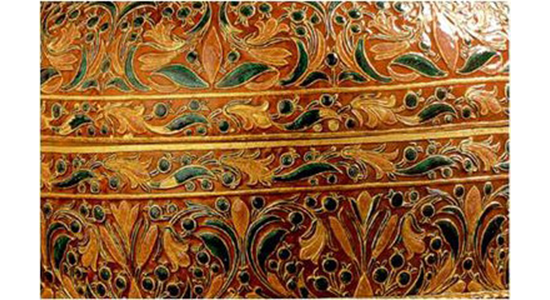A pattern of trumpet flowers and pomegranates: a modified pattern from the reign of King Rama V on the regalia in the possession of Princess Maha Chakri Sirindhorn
The gold royal utensils of Princess Chakri Sirindhorn
The royal utensils are not only for the king’s personal use, but are also given to the other royals and officers as gifts to glorify their ranks. This has been a tradition since ancient times. Various utensils which have been found at Phra Mahathat Temple and Raj Burana Temple can serve as clear evidence. During the early Rattanakosin period, gold royal utensils were still being made for royal use and as a royal gift for other royals as well as officers. Techniques and patterns used in the making vary according to popularity in each reign. Mostly, the same technique and decorative pattern are adopted and applied on gold royal utensils in the same set of regalia. The patterns found are those which had been popular since Ayutthaya period, and also those which have been incorporated with a foreign design.
In the current reign, the gold royal utensils, which had served as regalia to the late royals, have been selected to be given to the current royals, when they have been promoted to a higher rank.
The regalia, which belong to Princess Sirindhorn, are being exhibited in the Pavilion of Regalia, Royal Decorations and Coins in the Royal Palace. They are comprised of royal utensils, made with enameled gold, believed to have been produced during the reign of King Rama V. They were formerly in a set of royal wares used as a decoration to the female royals in special ceremonies, for example the royal tonsure ceremony. The oldest evidence of said regalia was an old photograph, showing the regalia which belonged to a female royal during the reign of King Rama V. It has also been found that the pattern of the same kind was applied on the utensils which comprise sets of regalia in possession of almost every female royal. This set of regalia was given to Queen Rambhai Barni by King Rama VII. In the current reign, they had been bestowed upon Princess Sirindhorn by King Bhumibol Adulyadej on 5th December 1977, on the occasion that the princess (Her Royal Highness Princess Sirindhorn Debaratanasuda) had been promoted to a higher rank. The new title according to the royal inscripted gold plate is "Somdet Phra Theppha Rat Ratcha Suda, Chao Fa Maha Chakri Sirintdhorn, Ratta Sima Khunakon Piya Chat, Sayam Boromma Ratcha Kumari”. This is considered the highest rank for female royals, which had not existed ever before in the Royal Thai Court.
According to the historical background of this set of regalia, the set had been in use since the reign of King Rama V, up until the current reign. One distinctive characteristic of the set is its unique pattern. The pattern is a modified traditional Thai pattern called intertwining sprays of trumpet flowers and pomegranates, which seem different from the original pattern. This pattern is found on a petalled betel tray, a small jar with a tapering tip, a betel cup, a betel case, a drinking bowl with a lid, a tray and a small cup in the set. It is not found in any other regalia or other royal utensils which are being exhibited in the Pavilion of Regalia, Royal Decorations and Coins.
A pattern of trumpet flowers and pomegranates
The design of the pattern
The pattern is in a design of flower vines in order to imitate nature. What is unique is a design of long-petalled flowers enameled in pink, long fine leaves with fruits enameled in green, and intertwining stalks enameled in red. This pattern of botanical vines can usually be found in Thai art during the reign of King Rama V. It is similar to the pattern of intertwining leaves in foreign style found on the ceiling of the main chapel in Wat Ratchabopit Sathitmahasimaram Ratchaworawihan Temple, which was built in 1869 AD. It is similar to the pattern of intertwining curled stalks on the ceiling of the main chapel in WatDebsirindravas Voraviharn Temple, which was built in 1878 AD. Furthermore, the pattern is also similar to the vine pattern on the royal gown on which there was an embroidery of the royal monogram of King Rama V. This royal gown was a regalis in the clothing category, contemporaneous to aforementioned objects. It is being exhibited at the Pavilion of Regalia, Royal Decorations and Coins as well. The pattern is of floral vines, resembling the pattern of acanthus leaves found in Western architecture. Additionally, the reign of King Rama V was the period when Western art had enormous influence on Thai art. Thus, this particular pattern is consistent with the background story about when this set of regalia was made.
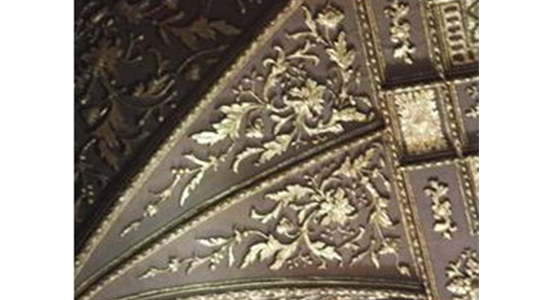
The pattern of interwining leaves in foreign style found on the ceiling of
the main chapel in Ratchabopit Sathitmahasimaram Ratchaworawihan Temple
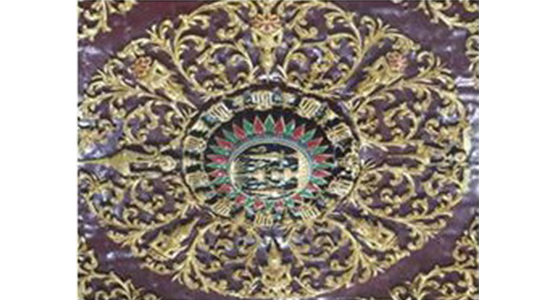
The pattern of interwining curled stalks on the ceiling of the main chapel
in Debsirindravas Voraviharn Temple
The earliest evidence of the intertwining trumpet flowers and pomegranates pattern such as this one was a photograph from a royal tonsure ceremony in 1878 AD. The pattern appeared on the regalia belonging exclusively to female royals. In the photograph, the regalia were being place next to where Her Royal Highness Princess Srivilailak was being seated. This set of regalia is assumed to be the same one which was in use during the early period of King Rama V’s reign. There is a photographic evidence of other female royals accompanied by regalia with the same decorative pattern. This is consistent with the royal decree to commission additional productions of regalia for female royals in the year 1878. The pattern to adorn the aforementioned regalia could have been one of intertwining trumpet flowers and pomegranates. This is because said pattern has been found only on the utensils which had been bestowed onto female royals of the court. These items are drinking bowls made from enamelled gold along with lids and drinking cups, round jars with a tapering tip or round betel cups. Hence, the pattern of this kind, i.e. the modified patterned, is considered to be representing a unique characteristic of the patterns on gold utensils in the reign of King Rama V.

The regalia were being place next to where Her Royal Highness Princess Srivilailak
was being seated in royal tonsure ceremony in 1878 AD
The background idea and the meaning to the pattern.
Normally gold utensils for royal use are decorated with botanical vine pattern, comprised of flowers, leaves, and fruits. The main design is long-petalled flowers in pink color. It can be observed that the design of the flowers resembles that of trumpet flowers which appeared on commemorative Pod Duang coins. These coins are made in 1880 for the ceremony to donate merit to the Queen Debsirindra. The ceremony was held when King Rama V reached the same age as the Queen mother when she had passed. Thus, the flowers in the floral vine were meant to be trumpet flowers. As for the meaning of the flower, the flower was selected because the former name of the Queen Mother was "Rampoei” (, which means trumpet flower). Due to this reason, trumpet flowers were used to decorate regalia for female royals of the court. This kind of pattern has only been found on these regalia. It was used on the gold utensils exclusively for the use of female royals of the court. There has been no discovery of this pattern on any gold utensils consisted in the regalia owned by male royals or in any other sets of royal utensils.

The pattern of trumpet flowers which appeared on commemorative Pod Duang coins
The pattern of intertwining trumpet flowers and pomegranates appears solely on the set of regalia which belong exclusively to Prince Sirindhorn. The pattern is used to decorate gold utensils which have a clear history of its creation. Its appearance can be spotted in photographs of several royals of the court of King Rama V. Moreover, that the flowers are enameled in pink is one unique characteristic of gold utensils which were made during the reign of King Rama V. The pink enamel is related to the fact that pink color is the color of the day in which the King Rama V was born; it was also the King’s favorite color at the time
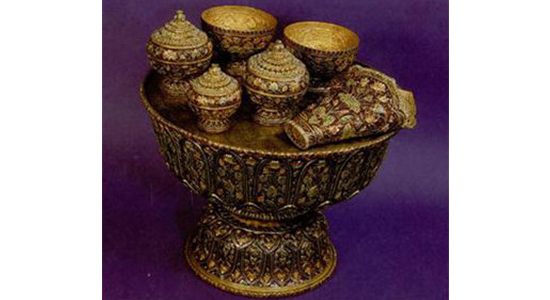
The gold utensils for female royals made from the reign of King Rama V
Apart from the main engraving of the flowers with long petals, which resembles trumpet flowers and signifies its exclusive use among the female royals, there is also a minor design of pomegranates incorporated in the pattern. The fruit is believed to have an auspicious meaning according to a Chinese belief. The design of the fruit is of small, round shape, with a two-way split at one side to replicate the rear of an actual pomegranate. The inside of the design is fully carved into small seeds. According to Chinese beliefs, the design of pomegranates signifies fertility and a lot of heirs. Not only is it considered auspicious, it also represents the King’s good wishes to those who received the gold utensils bearing this pattern. This is also consistent with the notion that the utensils were being given to glorify the honor of female royals of the court. They convey the same meaning as the gold utensils with a lotus pattern or a cluster of lotus plants. The utensils with this pattern are a set of petalled betel tray made with enameled gold. The entire set is engraved with clusters of lotus plants. It is believed to be made by craftsmen from the early period of King Rama V’s reign.
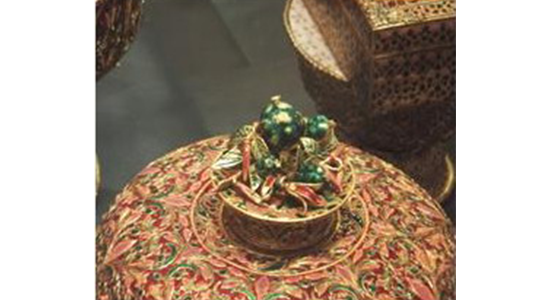
The cluster of lotus plants
Regarding the pattern of clusters of lotus plants which is found on the aforementioned betel tray with petals, Chinese people believe that lotus flowers signify wishes for the receiver to bear a lot of children, a lot of male heirs, or to become with child very soon. This is also consistent with the fact that the items were to be bestowed upon female royals. The meaning of the lotus pattern is similar to that of the pomegranates. It can be observed that Chinese beliefs were incorporated harmoniously into the patterns. This suggests that at the time it was common to design patterns, in this case Chinese, to convey an auspicious meaning relating to the receivers.
The appearance of this intertwining vine pattern suggests an adoption of a Western influence, resulting in a modified pattern that differs significantly from the traditional ones. Intertwining floral patterns had existed in Rattanakosin art before the time of King Rama V. The clear evidence to this is a model stupa from the period of King Rama IV on which there is a similar botanical vine pattern appearing alongside pink flowers. The stupa is being exhibited in the National Museum. Due to the similitude of the two patterns, it is assumed that the vine pattern of trumpet flowers and pomegranate might have drawn an inspiration from the botanical vine pattern from the earlier reign.
On the pattern of intertwining trumpet flowers and pomegranates, the flowers are enameled in pink; the fruits are enameled alternately in green. The same manner is applied with the lid of the drinking bowl. It was made into a shape of an actual pomegranate, which has auspicious meaning according to Chinese beliefs. The realistic imitation of fruits was in fashion due to Western arts having become a very strong influence on traditional Thai art during the period of King Rama V. Hence, the pattern applied on this group of royal utensils is called, "the pattern of intertwining trumpet flowers and pomegranates.”
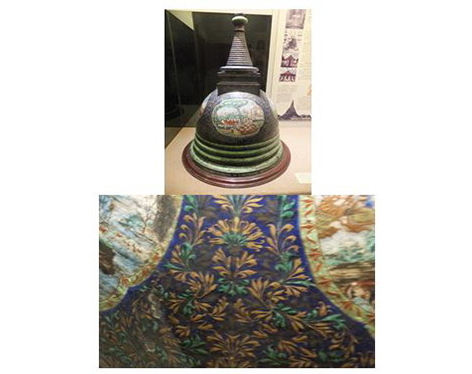
The model stupa from the period of King Rama IV is being exhibited
in the National Museum Bangkok
Techniques used to create the pattern
Techniques used to create the pattern of trumpet flower vine and pomegranates is embossing and enameling - the same techniques to create enameled gold wares. The pattern is enameled fully. The process begins with molding the item into a desired container shape. After that, the item undergoes a process to emboss the pattern as previously designed. The embossment elevates the outside of the design so that the color solution stays in the lines which form the pattern. The background is enameled in red while the designs are enameled in green and pink.
Apart from the surface area, the lid of the bowl is also decorated, i.e. made into a shape of an actual fruit with a pedicel. This kind of decoration, namely creating a realistic imitation of an auspicious fruit according to a Chinese belief, had never been found anywhere else among Thai royal gold utensils. This is another special characteristic of gold wares in the time of King Rama V. Apart from the pink enamel which can be found quite commonly on gold wares during this reign, it has also been established that the design of the pattern was used on regalia particularly owned by female royals. This is due to the fact that the pattern has been found only on the lid bowls made with enameled gold, betel cups and gold jars with tapering lids; these are regalia exclusively for female royals.
It can be said that the pattern of intertwining trumpet flowers and pomegranates is a modified pattern, uniquely used on this particular set of regalia. The design of the pattern was an influence of Western art, which was favored by the King at the time. It incorporates an auspicious meaning according to a Chinese belief which has been integrated in Thai art of Rattanakosin period since the reign of King Rama III. Thus, this pattern is unique to this set of royal wares. It is designated to decorate the regalia bestowed to royal females, in order to convey an auspicious massage which relates directly to the receiver. In this manner, the bestowal of the regalia not only signifies a promotion of ranks, but it is at also a wish of fortune as well.
Translated from
Somsak Ritpakdee. (2014). A pattern of trumpet flowers and pomegranates: a modified pattern from the reign of King Rama V on the regalia in the possession of Princess Maha Chakri Sirindhorn. (Thai version) Retrieved August 14, 2014, from Pavilion of Regalia, Royal Decorations and Coins e-museum: http://emuseum.treasury.go.th


